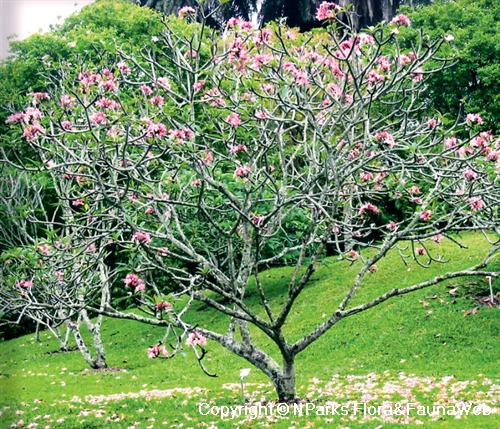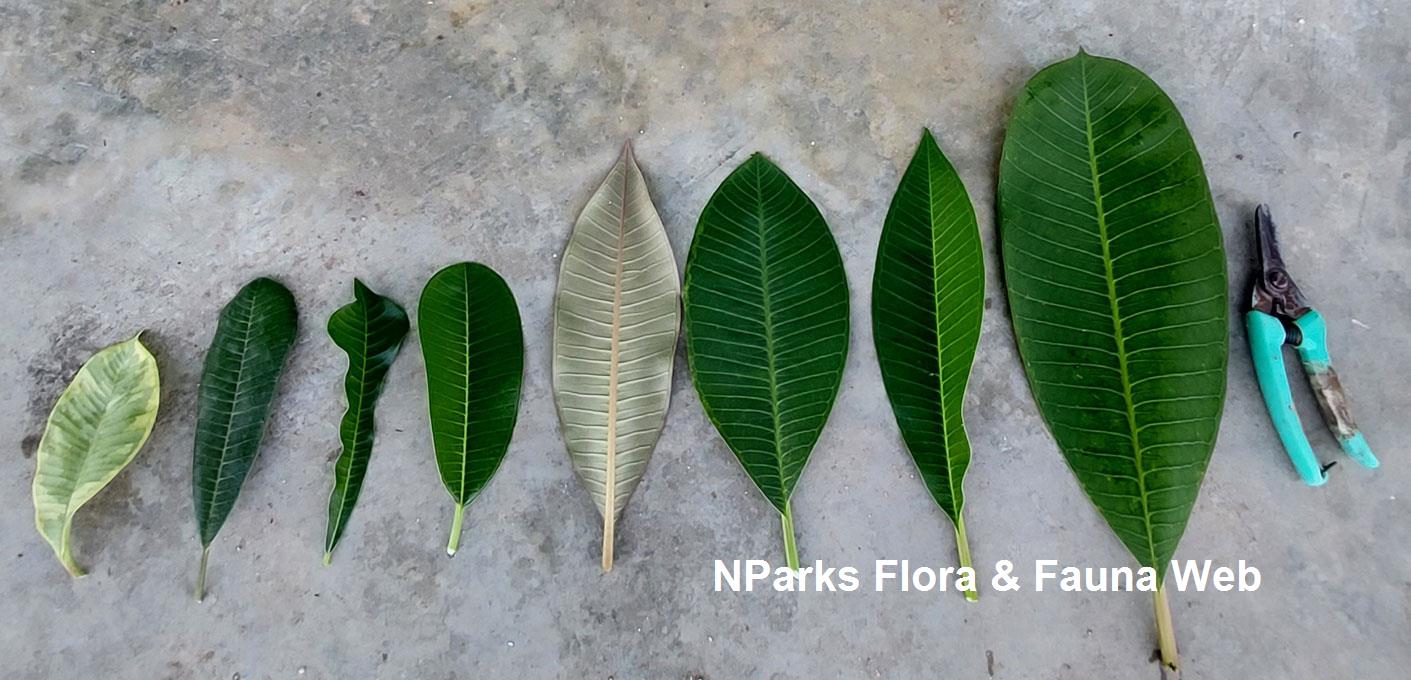
Back
Plumeria rubra
| Family Name: | Apocynaceae |
| Synonyms: | Plumeria acuminata |
| Common Name: | Frangipani, Common Frangipani, Kemboja, Bunga Kubur, Red Frangipani, Nosegay Frangipani, Chempaka, Pagoda Tree, Camboja |
Name
Classifications and Characteristics
| Plant Division | Angiosperms (Flowering Seed Plants) (Dicotyledon) |
|---|---|
| Plant Growth Form | Tree (Small (6m-15m), Shrubby (1m-5m)) |
| Lifespan (in Singapore) | Perennial |
| Mode of Nutrition | Autotrophic |
| Plant Shape | Vase, Open |
| Maximum Height | 8 m |
| Maximum Plant Spread / Crown Width | 8 m to 10 m |
Biogeography
| Native Distribution | Tropical Americas (Costa Rica, El Salvador, Guatemala, Mexico, Nicaragua, Panama, Venezuela, Colombia) |
|---|---|
| Preferred Climate Zone | Tropical |
Description and Ethnobotany
| Others - Plant Morphology | Small tree, up to 8m height. Leaves thick and leathery. Free-flowering. Flowers showy, fragrant, attract pollinators (Spinx Moths) but without nectar reward. Flower colour varies with cultivar.Cut surfaces of plant produce poisonous milky sap. Propagate by seeds, or hardwood cuttings (allow cut end to dry for several days before inserting into media).Ideal tree for small gardens and roof gardens. Genus named after French botanist Charles Plumier, who explored New World tropics. |
|---|
Landscaping Features
| Desirable Plant Features | Fragrant (Flowers) (Time Independent, Day), Ornamental Flowers |
|---|---|
| Landscape Uses | General, Suitable for Roadsides, Skyrise / Balcony, Container Planting, Coastal |
| Thematic Landscaping | Fragrant / Aromatherapy Garden, Naturalistic Garden |
| Usage Hazard - Cons | Irritant - Sap |
| Usage Hazard - Cons Remarks | Poisonous milky sap on cut surfaces of plant |
Fauna, Pollination and Dispersal
| Pollination Method(s) | Biotic (Fauna) (Flowers attracts and are pollinated by Spinx Moths, but do not produce nectar reward., Insects (Butterfly, Moth)) |
|---|---|
| Seed or Spore Dispersal | Abiotic (Explosive Dehiscence) |
Plant Care and Propagation
| Light Preference | Full Sun |
|---|---|
| Water Preference | Moderate Water |
| Plant Growth Rate | Moderate |
| Rootzone Tolerance | Well-Drained Soils, Saline Soils / Salt Spray, Drought Tolerant |
| Maintenance Requirements | Moderate |
| Pruning | Requires pruning for strong structure and remove drooping branches as tree gets older. |
| Diseases | Common pests include scales, caterpillars, nematodes. Root rot can infect plants planted in poorly-drained soils. |
| Pest(s) | Associated with, Nematodes, Sucking Insects |
| Propagation Method | Seed, Stem Cutting |
| Propagule Establishment Remarks | Hardwood cuttings need to be dried for several days before potting in well-drained media. Leafy tip cuttings should be potted immediately. |
| Propagation Method Remarks | Hardwood stem cuttings, leafy tip cuttings |
| Planting Distance | 8 m to 10 m |
Foliar
| Foliage Retention | Deciduous |
|---|---|
| Mature Foliage Colour(s) | Green |
| Mature Foliage Texture(s) | Smooth, Glossy / Shiny, Leathery, Thick |
| Prominent Young Flush Colour(s) | Orange |
| Foliar Type | Simple / Unifoliate |
| Foliar Arrangement Along Stem | Alternate |
| Foliar Shape(s) | Non-Palm Foliage (Obovate, Oval, Elliptical) |
| Foliar Venation | Pinnate / Net |
| Foliar Margin | Entire |
| Typical Foliar Area | Notophyll ( 20.25cm2 - 45 cm2 ) |
| Leaf Area Index (LAI) for Green Plot Ratio | 2.5 (Tree - Open Canopy) |
Non - Foliar and Storage
| Trunk Type (Non Palm) | Woody |
|---|---|
| Stem Type & Modification | Woody |
| Root Type | Underground (Tap Root, Fibrous Root) |
Floral (Angiosperm)
| Flower & Plant Sexuality | Bisexual Flowers |
| Flower Colour(s) | Pink, Purple, Red, White, Yellow / Golden |
|---|---|
| Flower Symmetry | Radial |
| Flowering Period | Free-Flowering |
| Flowering Opening Time | Time-Independent |
| Flowering Habit | Polycarpic |
Fruit, Seed and Spore
| Mature Fruit Colour(s) | Black, Brown |
|---|---|
| Fruit Classification | Simple Fruit |
| Fruit Type | Dehiscent Dry Fruit |
Image Repository
Others
| Master ID | 1781 |
|---|---|
| Species ID | 3074 |
| Flora Disclaimer | The information in this website has been compiled from reliable sources, such as reference works on medicinal plants. It is not a substitute for medical advice or treatment and NParks does not purport to provide any medical advice. Readers should always consult his/her physician before using or consuming a plant for medicinal purposes. |









